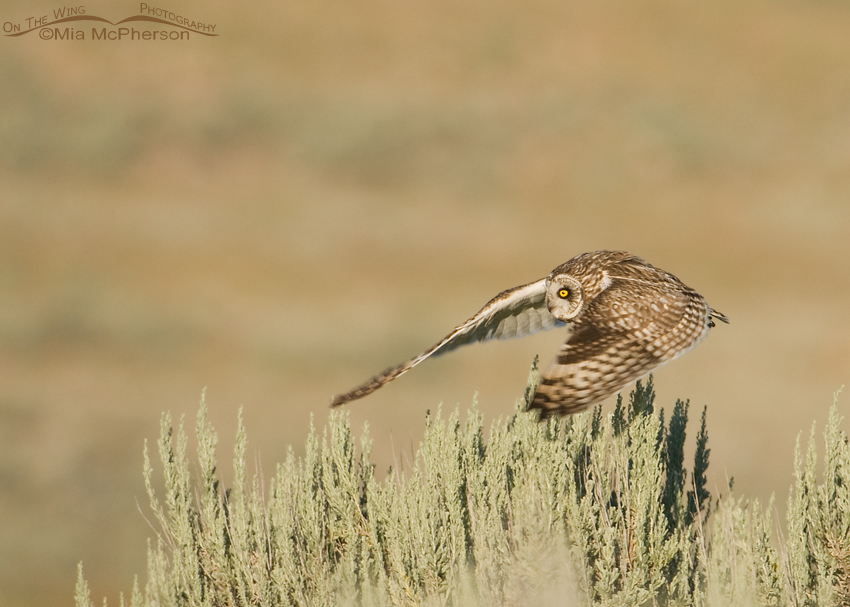 Adult Short-eared Owl lifting off from a sagebrush – Nikon D200, f6.3, 1/640, ISO 400, +0.3 EV, Nikkor 200-400mm VR with 1.4x TC at 400mm, natural light, not baited
Adult Short-eared Owl lifting off from a sagebrush – Nikon D200, f6.3, 1/640, ISO 400, +0.3 EV, Nikkor 200-400mm VR with 1.4x TC at 400mm, natural light, not baited
Yesterday morning I spotted a Coyote walking across a road on Antelope Island then I noticed some ticked off Black-billed Magpies near the coyote. Soon after that I saw the shape of a larger bird near where the Coyote had gone into the sagebrush which turned out to be an adult Short-eared Owl. The Owl flew around where I suspected the Coyote to be then it landed on top of a sagebrush. The Coyote had obviously upset the owl.
When I am out looking for birds to photograph I’m not always just looking for the birds themselves, instead I have found that by paying attention to habitat, movements and other animals in the area that it can often lead to interesting surprises as it did yesterday. I knew that the owl normally wouldn’t have been bothered by the presence of the Coyote.
I had seen the Short-eared Owl adults in this particular area over the past several weeks and had wondered if they had a nest nearby. I don’t need to wonder any more.
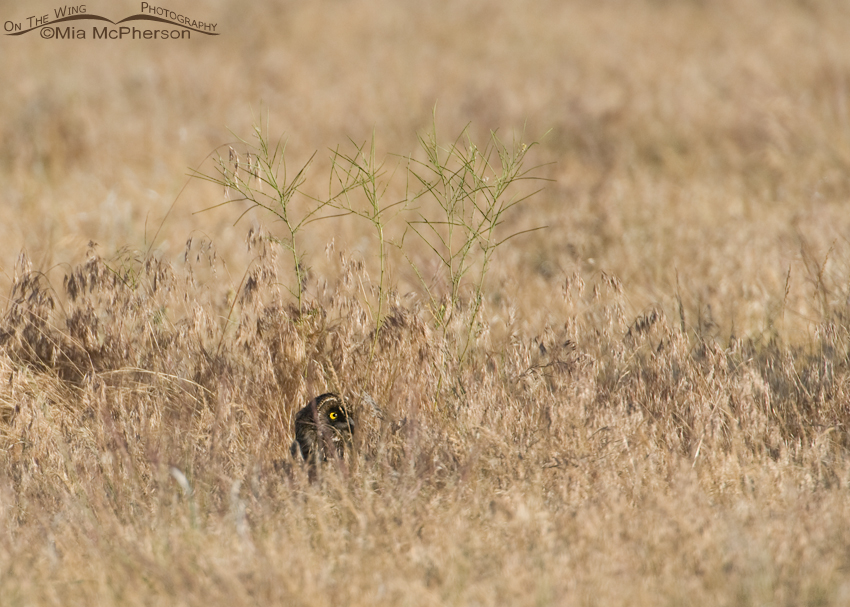 Hidden Juvenile Short-eared Owl – Nikon D200, f6.3, 1/640, ISO 400, +0.7 EV, Nikkor 200-400 mm VR with 1.4x TC at 400mm, natural light, not baited
Hidden Juvenile Short-eared Owl – Nikon D200, f6.3, 1/640, ISO 400, +0.7 EV, Nikkor 200-400 mm VR with 1.4x TC at 400mm, natural light, not baited
In just a few moments I saw an adult owl fly in with prey and it landed in the grasses, as it did that there was a flutter of wings, too many to be just from the adult owl. Driving around in that general area I could see movement here and there, the shape of a head then the eyes of fledgling owls. There were possibly four juveniles that were spread out all over the grassy field. They were hidden by the grasses and vegetation but not hidden enough for my well trained eye.
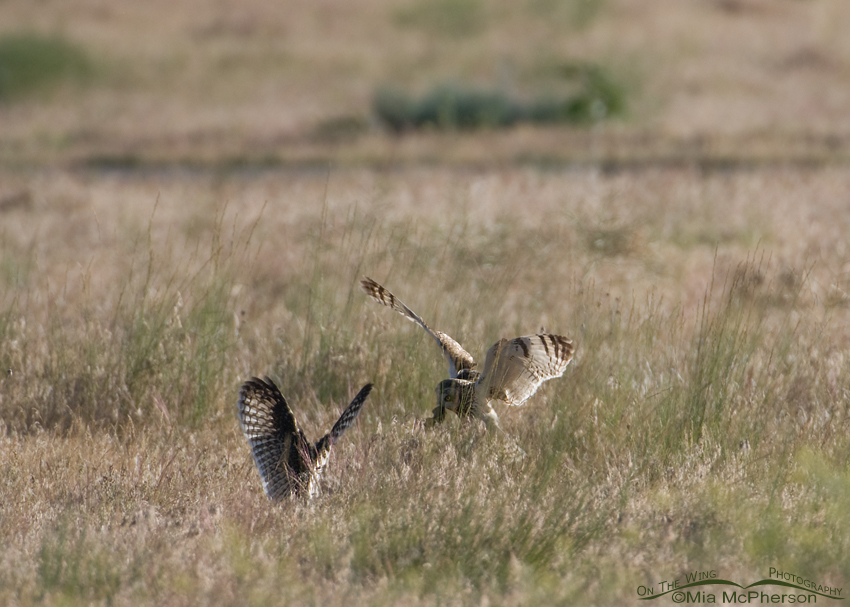 Adult Short-eared Owl bringing a vole to a fledgling – Nikon D200, f6.3, 1/640, ISO 400, +.07 EV, Nikkor 200-400mm VR with 1.4x TC at 400mm, natural light, not baited
Adult Short-eared Owl bringing a vole to a fledgling – Nikon D200, f6.3, 1/640, ISO 400, +.07 EV, Nikkor 200-400mm VR with 1.4x TC at 400mm, natural light, not baited
I don’t know how the adult Short-eared Owls keep up with the location of the fledglings but they did not seem to have any real problems spotting them when they were bringing in prey to feed the young owls. Trying to keep up with two teenagers used to give me massive headaches I can not imagine having 4 or more spread out all willy-nilly!
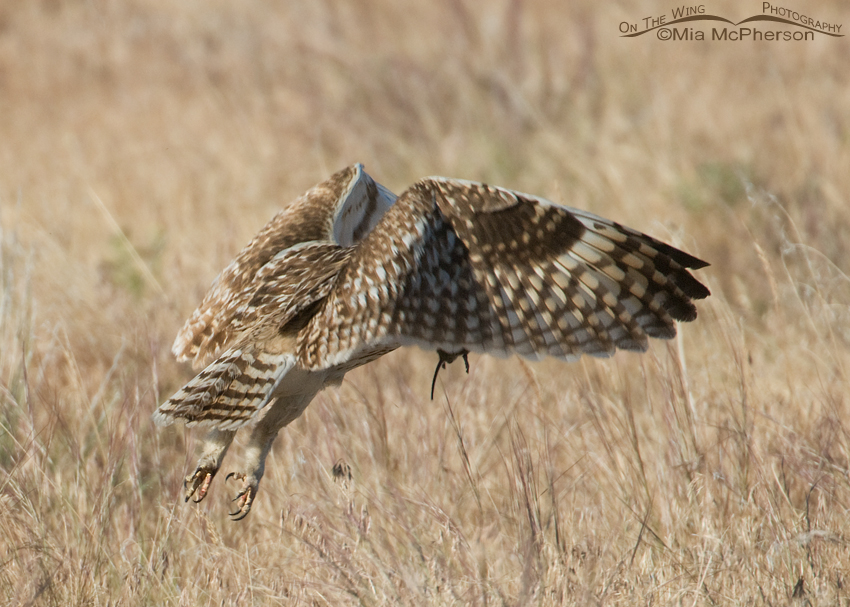 Adult Short-eared Owl prey for fledgling – Nikon D200, f6.3, 1/1250, ISO 400, Nikkor 200-400mm VR with 1.4x TC at 400mm, natural light, not baited
Adult Short-eared Owl prey for fledgling – Nikon D200, f6.3, 1/1250, ISO 400, Nikkor 200-400mm VR with 1.4x TC at 400mm, natural light, not baited
Both the male and female adult Short-eared Owls kept very busy hunting and then bringing in the prey to the fledglings. The fledgling owls made hissing noises which I assume not only help the adults locate them but it might also express the degree of hunger they have. Later in the morning as the temperatures rose the activity slowed down dramatically. I believe the owls were trying to find shelter from the heat in the vegetation nearby.
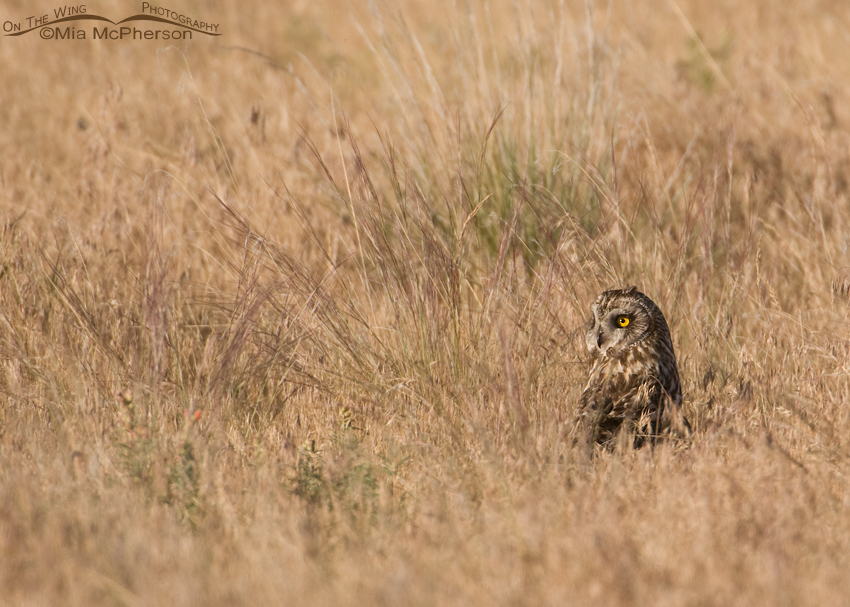 Female Short-eared Owl in grasses – Nikon D200, f6.3, 1/1250, ISO 400, Nikkor 200-400mm VR with 1.4x TC at 400mm, natural light, not baited
Female Short-eared Owl in grasses – Nikon D200, f6.3, 1/1250, ISO 400, Nikkor 200-400mm VR with 1.4x TC at 400mm, natural light, not baited
While I did not bring home any spectacular shots because the fledgling Short-eared Owls were simply too far away I did bring home some fantastic memories of this Short-eared Owl family. I also learned more about the species by observing them without my presence upsetting their normal behavior which may help me in the future in obtaining images of Short-eared Owls near their chicks.
So, a coyote’s behavior along with the ticked off Black-billed Magpies lead me to an very interesting find. Had I not seen those behaviors I may have not spotted the owls and their young.
Life is good.
Mia
PS; the image directly above was my favorite of the owl images I created yesterday. A hidden beauty.
Click here to see more of my Short-eared Owl photos plus facts and information about this species.


Well, I am sure that in time you will get that spectacular shot you desire, but for now you have these images as a reminder of your experience.
With so many of the birds that I photograph, or attempt to photograph, I value the time (as you do) that I spend observing them and learning about their lives. Using a camera instead of binoculars enhances that experience, in my opinion, because then you have a record of what you saw. I suspect that you and I have similar reasons to pursue bird photography, so I will relate a little conversation I had with a friend at dinner when I was in California last week for the Mono Lake Bird Chautauqua. My friend’s husband is an excellent birder, and one of the organizers of the festival, so I was in the company of experts all weekend. Somehow the topic of labels came up, and she asked me if I ever went out to watch for birds without my camera. I said no, I always had a camera, and usually did not use my binoculars. Actually, I do observe birds without my camera-in my back yard, as well as when I am walking my dogs. Anyway, her conclusion was that since I always had to take pictures, I was not a birder, but a bird photographer. Now this irritated me a bit, because I do spend a lot of time studying birds in the field, and later, when I am looking at my photos. This is my process, and I enjoy it, so I guess it doesn’t matter what other people call me- I just love to photograph birds!
Julie, I read your “conversation” and giggled because I have had that happen too. I’m asked a lot whether I am a “birder” or a “bird photographer”. I don’t normally go any where that I might come across birds without a camera and rarely use binocs. I don’t tic birds off of a list although on long trips I do write down which species I see. I study birds every time I photograph them and store that info away in my head in case I come across the bird or situation again. I study my reference guides and learn from them. I know that with most birders it doesn’t matter what time of the day they go out looking for birds, for me I do want the good light for photography. I have birder friends who say I am more birder than bird photographer but I think they are biased because they like me. I know I am a bird photographer through and through and like you it just does not matter what other people call me because I just love to photograph birds and be out in nature.
Awesome! What a great sighting!